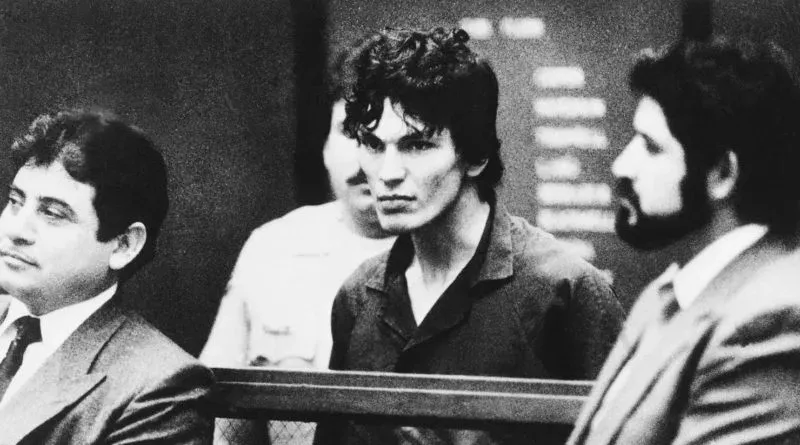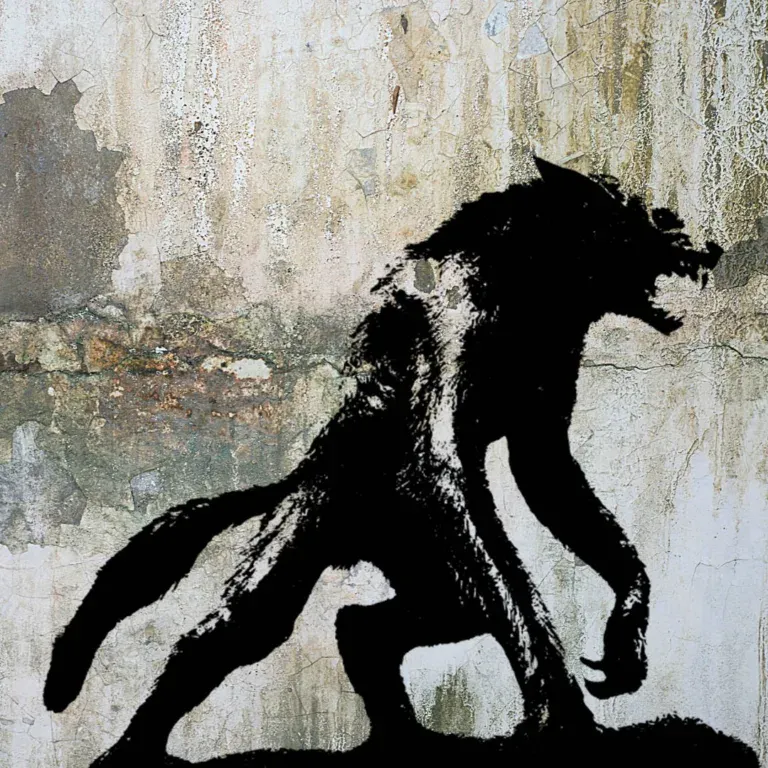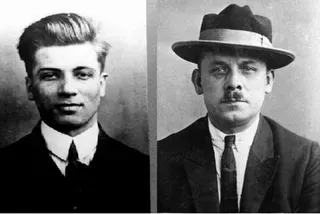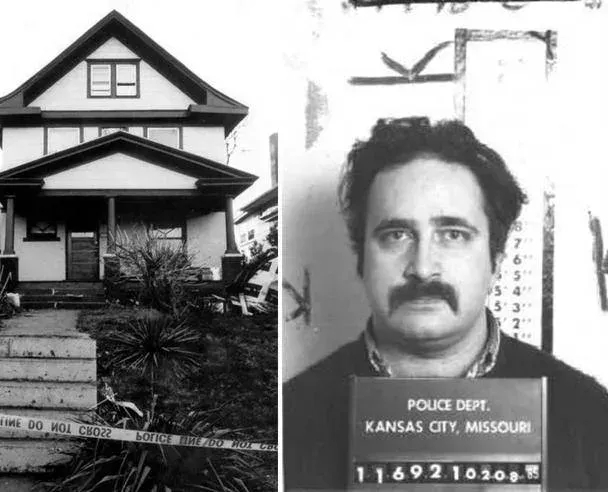Richard Ramirez – Night Stalker: “The Night Predator”
Richard Ramirez – Night Stalker: “The Night Predator”
Introduction
Richard Ramirez, also known as “The Night Stalker,” is one of the most infamous and feared serial killers in American criminal history. Between 1984 and 1985, Ramirez spread terror across California, mainly in the city of Los Angeles, leaving behind a trail of brutal murders and violent crimes. His sinister figure, ruthless behavior, and declared devotion to Satanism made him one of the most enigmatic and disturbing figures in the criminal landscape. This article will explore the life of Richard Ramirez, the crimes he committed, his trial, and the lasting impact he had on popular culture and criminology.
The Life of Richard Ramirez
Childhood and Youth
Ricardo Leyva Muñoz Ramirez was born on February 29, 1960, in El Paso, Texas, into a family of Mexican origin. He was the youngest of five children. His childhood was marked by traumatic experiences and negative influences that would contribute to shaping his future criminal life. Ramirez’s father, Julian, was a former police officer turned railroad worker, known for his outbursts of anger and physical abuse toward his children. These episodes of domestic violence left an indelible mark on young Richard.
Another key figure in his life was his cousin Miguel Ramirez, a Vietnam War veteran, who introduced Richard to violence in an extremely graphic manner. Miguel showed Richard photographs of Vietnamese women he had tortured, raped, and killed during the war. This early exposure to extreme and senseless violence left a deep impression on Richard, who began to develop a morbid interest in death and suffering.
Descent into Crime
During his teenage years, Richard began to exhibit deviant behavior. He started stealing and abusing drugs, particularly marijuana and LSD. He also developed a growing interest in Satanism, attracted by the dark and rebellious aesthetic it represented. At the age of 22, Ramirez moved to Los Angeles, where his life took an irreversible turn towards crime.
The Murders and Crimes of Richard Ramirez
The First Murder
On June 28, 1984, Richard Ramirez committed his first known murder, that of Jennie Vincow, a 79-year-old woman living alone in Los Angeles. Ramirez entered her home through an open window, stabbed her repeatedly, and slit her throat, leaving her body in a horrific state. This murder marked the beginning of a series of crimes that would terrorize Southern California.
The 1985 Crime Spree
In 1985, Richard Ramirez escalated his campaign of terror. During the summer months, he engaged in a series of home invasions, robberies, rapes, and murders. The brutality of his crimes was shocking: he often tortured his victims before killing them, using firearms, knives, hammers, and other tools. He also left satanic symbols at crime scenes, such as pentagrams drawn with the victims’ blood.
Among Ramirez’s most notorious crimes were the murders of Vincent and Maxine Zazzara, a couple killed in their home in Whittier, California. Ramirez shot Vincent Zazzara and then raped and tortured Maxine before brutally killing her. In another case, he shot Bill Doi, an elderly man, and then raped his wife Lillian, leaving her alive. These crimes, characterized by random violence and a total lack of empathy, made Ramirez one of the most wanted men in America.
The Modus Operandi of Ramirez
Richard Ramirez’s modus operandi was as unpredictable as it was cruel. Unlike many serial killers, who follow a precise pattern, Ramirez targeted people of all ages, ethnicities, and social conditions. His victims included men, women, and even children, and his method of killing varied from time to time. This unpredictability made it even more difficult for the police to connect the crimes and capture him.
Ramirez was known for entering his victims’ homes during the night, which led to his nickname “The Night Stalker.” He often entered through unlocked windows or doors, surprising his victims while they slept. Once inside, he inflicted physical and psychological torture, sometimes forcing them to pledge their allegiance to Satan before killing them.
April 10, 1984 – The First Victim
Mei Leung, nine years old, a Chinese-American girl, was killed in the basement of the San Francisco hotel where Ramirez was staying. She was raped and stabbed to death before Ramirez hung her body from a pipe. However, this crime was initially not identified as part of his criminal spree. It was only in 2009 that her DNA matched a sample obtained from the crime scene. In 2016, officials revealed that a second suspect was likely present due to DNA evidence, but had not been publicly identified due to a lack of evidence.
June 28, 1984
Jennie Vincow, 79 years old, was found murdered in her Los Angeles apartment, almost decapitated. Ramirez’s fingerprint was found on a screen door he had removed to gain entry into the apartment.
March 17, 1985
Ramirez attacked and killed Maria Hernandez, 22 years old, outside her home in Rosemead, California. He shot her in the face, but she survived after a bullet ricocheted off a set of keys. Her roommate, Dayle Yoshie Okazaki, was also shot in the head by Ramirez and killed. An hour later, Ramirez went to Monterey Park, where he shot Tsai-Lian “Veronica” Yu twice after pulling her out of her car.
March 27, 1985 – Whittier Murders
Ramirez entered a Whittier, California, home that he had previously burglarized. He fatally shot Vincent Charles Zazzara, 64, in the head while he was asleep. His wife, Maxine Levenia Zazzara, 44, woke up from the shot. Ramirez beat her and searched for valuables in the room. Maxine initially managed to escape and grab an unloaded gun. Ramirez shot her three times, then stabbed her, gouged out her eyes, put them in a jewelry box, and left. He left fingerprints in the flower beds and the bullets at this scene matched those from his previous attacks.
May 14, 1985 – Ramirez Attacks the Doi Family
Ramirez broke into the home of Bill and Lillian Doi in Monterey Park. He shot Doi in the face, beat him unconscious, then bound Lillian, searched for valuables in their home, and then raped her. Bill Doi died in the hospital.
May 29, 1985 – Ramirez Kills in Monrovia, Starts Driving a Stolen Car
Ramirez drove a stolen car to Monrovia, California, and broke into the home of Mabel “Ma” Bell and Florence “Nettie” Lang. He attacked Lang with a hammer, bound her in the bedroom, then tied up and assaulted Bell. He used Bell’s lipstick to draw a pentagram on her body and on the walls of both their bedrooms after raping her. The women were found alive two days later, but Bell eventually died from her injuries.
May 30, 1985 – Ramirez Terrorizes Burbank
Ramirez drove the stolen car to Burbank and broke into the home of Carol Kyle. He bound Kyle and her 11-year-old son, then asked the son to point out where the valuables were. He raped Kyle, bound her son, and then fled.
From these dramatic events and throughout the summer of 1985, the attacks continued in a fierce and relentless manner: among sexual assaults, horrific deaths, and burglaries, the population fell into an inescapable panic. The choice of victims was quite random, and no one felt safe. A task force composed of hundreds of agents was established to try to end this nightmare.
August 25, 1985, the Breakthrough:
Ramirez went to Mission Viejo in a stolen orange Toyota. The 13-year-old son of James Romero Jr. heard Ramirez outside and woke his parents. Ramirez fled, but the family was able to glimpse the color and make of his car and part of the license plate number. Ramirez then broke into the home of Bill Carns and Inez Erickson. He shot Carns three times in the head and told Erickson that he was the Night Stalker and that she had to swear to love Satan. After raping her, he told her, “Tell them the Night Stalker was here.” Erickson later provided officials with a description of Ramirez, and they were able to locate the stolen car in Los Angeles. There was a single fingerprint on the mirror that matched Ramirez’s. “We know who you are now, and soon everyone else will know,” officials said when they released a 1984 mugshot of him. “There will be no place you can hide.”
During his series of murders between 1984 and 1985, Ramirez stayed at the Cecil Hotel at a time when it was known as a place frequented by marginalized people, homeless individuals, drug addicts, and criminals. The Cecil Hotel was a perfect hideout for Ramirez, allowing him to remain unnoticed while planning his crimes.
According to various sources, Ramirez occupied a room on the upper floors of the hotel and often returned after committing his crimes, sometimes still covered in blood, but without drawing particular attention due to the already sinister reputation of the place.
Richard Ramirez’s association with the Cecil Hotel further contributed to the building’s dark notoriety, which has also been linked to several other unsettling events, including the case of Elisa Lam in 2013.
The Arrest and the Trial
The Arrest
Richard Ramirez’s long crime spree came to a head in August 1985, when the police finally managed to identify him as the prime suspect. Thanks to the fingerprints left at a crime scene and with the help of numerous witnesses, the authorities released a composite sketch and a photo of Ramirez.
On August 31, 1985, Ramirez was recognized by a group of East Los Angeles residents, who identified him while he was trying to steal a car. When the residents began to chase him, Ramirez attempted to flee, but was captured by the crowd and beaten until the police arrived to arrest him.
The Trial
Richard Ramirez’s trial began in 1988 and was one of the most-followed in American criminal history. During the trial, Ramirez often appeared contemptuous and provocative, openly displaying his devotion to Satanism. On one occasion, he raised his hand to show a pentacle drawn on his palm and shouted “Hail Satan!” in front of the judges and the public.
The case against Ramirez was solid: physical evidence, eyewitness testimony, and his connection to the crime scenes left no doubt about his guilt. On September 20, 1989, Richard Ramirez was found guilty of 13 murders, 5 attempted murders, 11 rapes, and 14 burglaries, among other crimes. He was sentenced to 19 life terms without the possibility of parole.
The Cultural Impact and Ramirez’s Death
The Legacy of Terror
Richard Ramirez is not only remembered as a serial killer but also as a symbol of embodied evil. His case has inspired numerous books, documentaries, films, and television series. His figure is often cited as an extreme example of how childhood abuse, early exposure to violence, and negative influences can contribute to the making of a ruthless criminal.
Death
Ramirez spent the rest of his life on death row at San Quentin State Prison in California. During his time in prison, he never showed remorse for his crimes and maintained his belief in Satanism. On June 7, 2013, Richard Ramirez died from complications related to lymphoma before he could be executed.
Conclusion
Richard Ramirez remains one of the most sinister figures in the history of American serial killers. His life, marked by violence from childhood, and his brutal crimes have left an indelible mark on the collective memory. His case continues to be studied by criminologists, psychologists, and scholars of evil to understand the depths of the human mind and the nature of wickedness. Although he is dead, the memory of his atrocities lives on, serving as a warning and a source of ongoing fascination in popular culture.
 Subscribe to our YouTube
Subscribe to our YouTube






